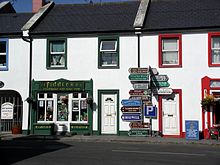Ballyvaughan
Ballyvaughan (also: Ballyvaghan , Irish : Baile Uí Bheacháin ; "Ó Beachán's townland") is a place in the west of the Republic of Ireland with 191 inhabitants (2016). It is on the southern edge of Galway Bay in northern County Clare and is the northern gateway to the Burren .
The original fishing village has developed into a sailing port and tourist destination and, with its restaurants and traditional pubs, is the starting point for exploring the sights of the northern Burren, which begins just a few kilometers south of the city. At the crossroads in the village where the coastal road N67 turns south, there is a signpost with over 15 signs, which is famous throughout Ireland and immortalized on many postcards.
On the road to Black Head (west of town) is Tobercornan "the Pinnacle well" one of the many holy wells in Ireland - here with a well house . In this area there is also an old cooking place from the Bronze Age - an Ancient cooking place or 'Fulacht Fiadh'. Close by is Gleninagh Castle ( Caislean Gleann Eiahneach ) the seat of the O'Loughlens clan, whose descendants lived in the castle until 1840. It is externally well preserved and a popular photo motif.
Newtown Castle is a round and therefore rare castle tower from the 16th century. It is a little south of the village. A small museum is attached to the restored castle, which has valuable written copies and provides information about the history of the area.
Another attraction near Ballyvaughan is Aillwee Cave . The accessible limestone cave is over two million years old. Since bear bones were found in a chamber, it is believed that bears hibernated in this cave before they were extinct in Ireland.
Web links
Coordinates: 53 ° 7 ′ N , 9 ° 9 ′ W

